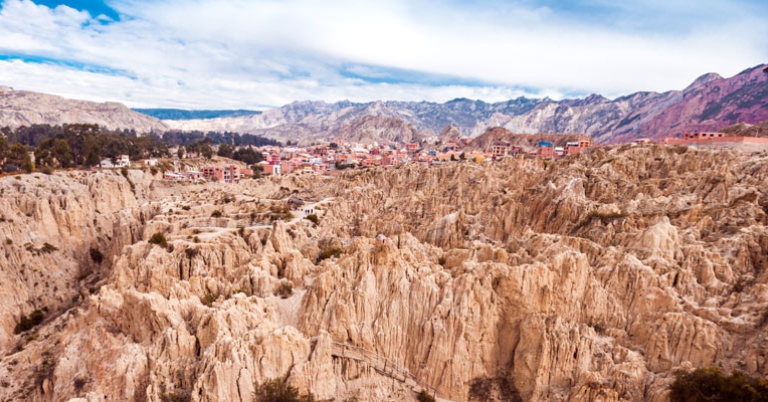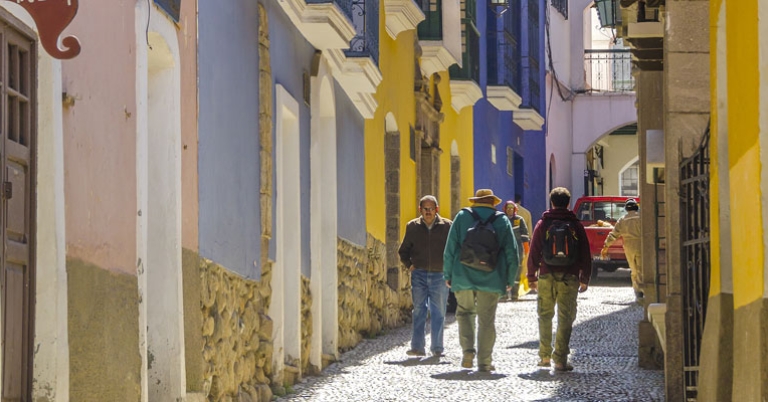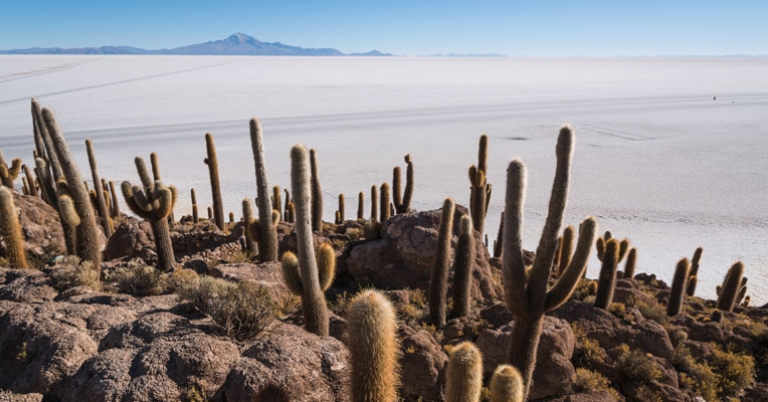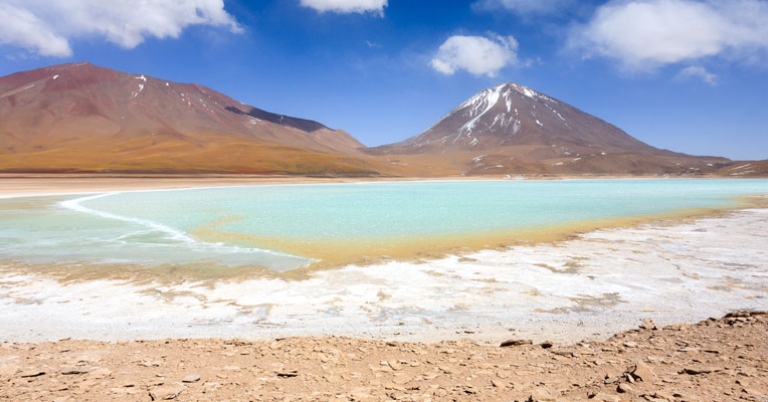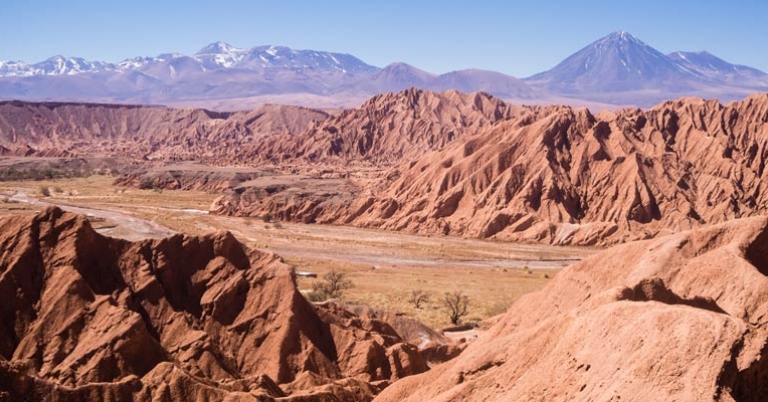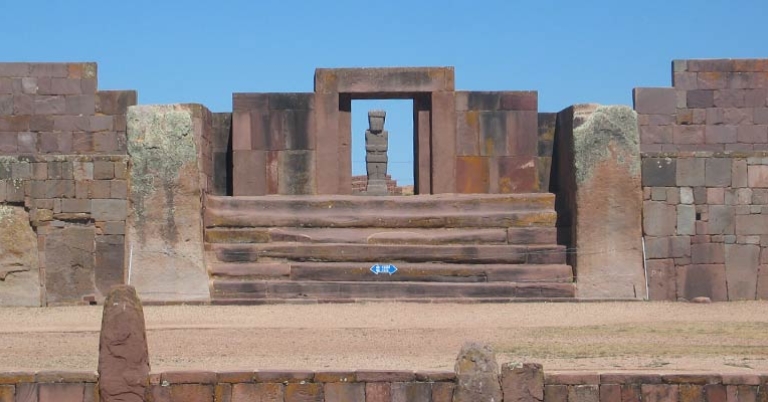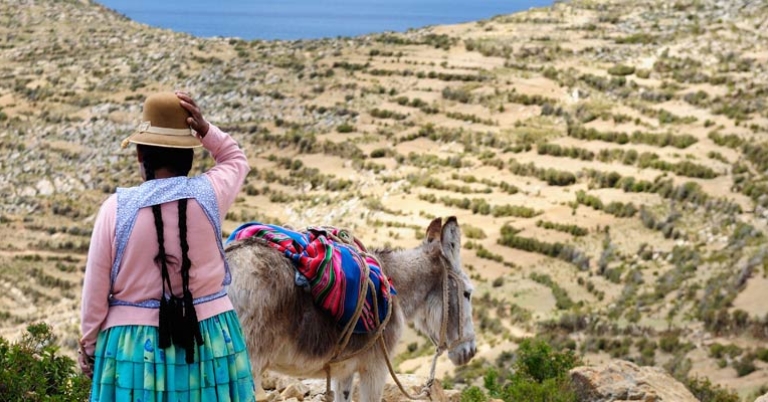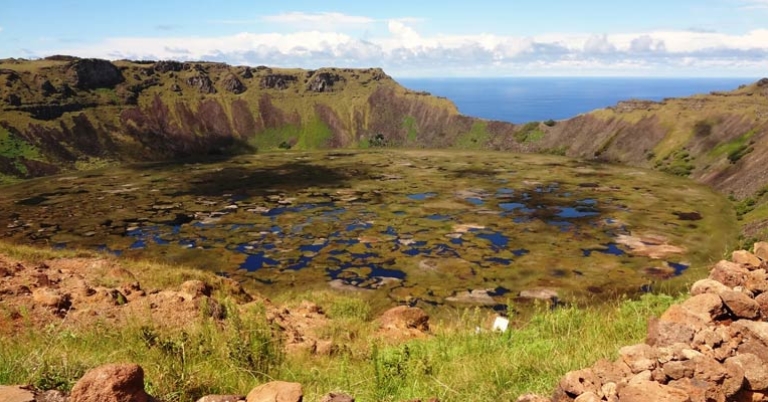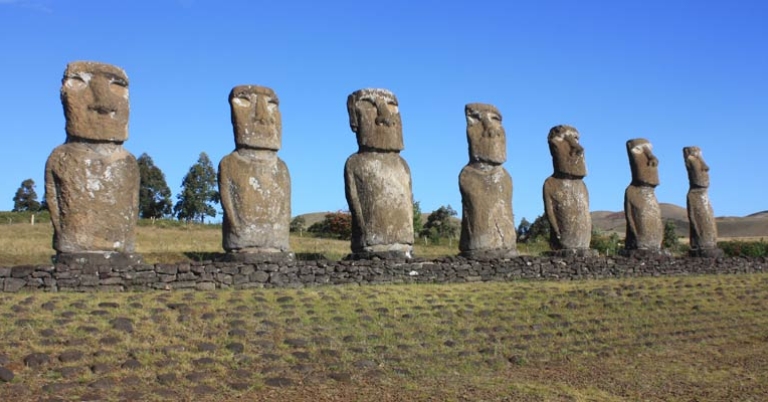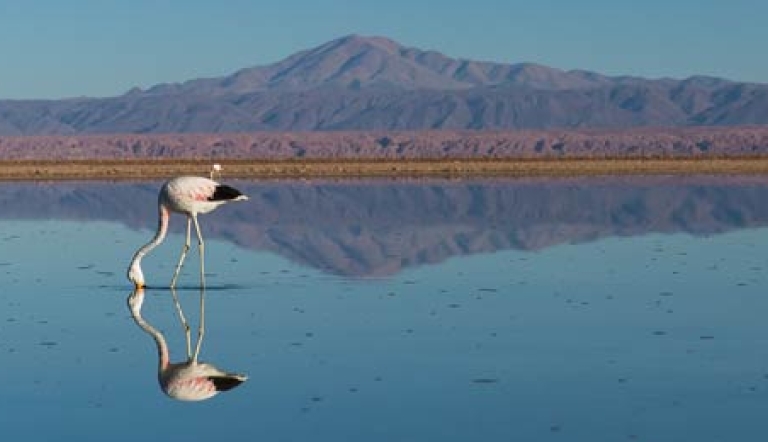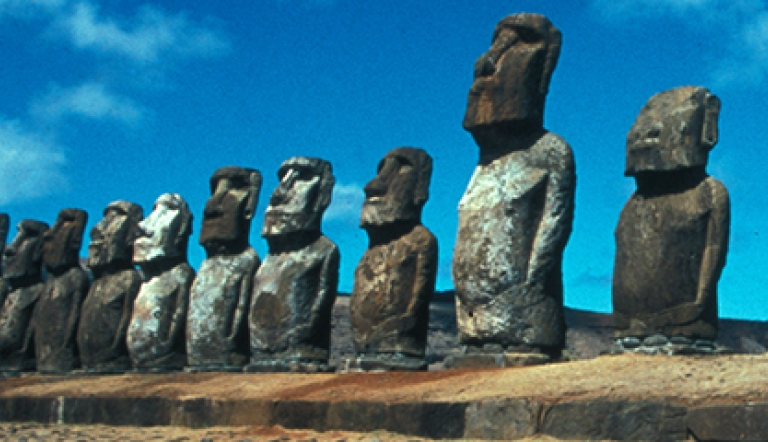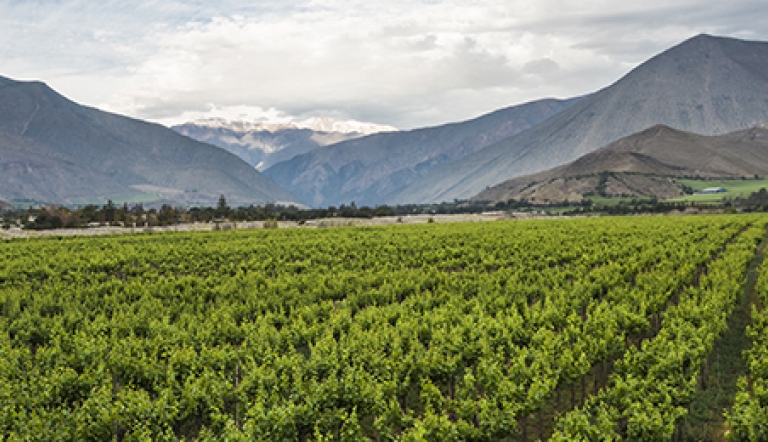Splendors of South America: Uyuni, Atacama and Rapa Nui
About this trip
Explore spectacular natural beauty and rich cultural heritage on this exciting adventure to some of South America's most iconic locations! The journey begins in Bolivia, where you'll learn about the history of the Inca at Lake Titicaca and stand amid the ethereal landscapes of Salar de Uyuni, the largest salt flats in the world. From there, continue to the dramatic stone and sand formations of Chile’s Atacama Desert. The experience culminates on the beautiful island of Rapa Nui, known for its mysterious and imposing moai statues. The itinerary is curated not only to include dream locations, but also to stay in luxury accommodations along the way.
This special trip is open to everyone, and your participation benefits the Climb for Cancer Foundation. The Foundation's travel program plays an important role in fundraising to support cancer patients and their families, while allowing explorers to check off bucket list travel experiences.
Highlights
- Set sail aboard a traditional reed boat on Lake Titicaca, where the Inca Empire was born.
- Explore the pre-Inca ancient city of Tinawaku.
- Take in extraordinary landscapes like colorful lagoons, sandstone formations, and sprawling salt flats.
- Marvel at the incredible geysers and take a dip in the hot springs pools at El Tatio.
- Discover clues to the ceremonial heritage behind the mysterious ruins of Rapa Nui, also known as Easter Island.
- Visit the coastal cities of Viña del Mar and Valparaíso, and sample Chilean wine.
PLEASE NOTE: A $500 per person minimum donation to the Climb for Cancer Foundation is required (to be paid separately). Additional donations may be made to the Climb for Cancer Foundation directly at https://www.climbforcancerfoundation.org/what-we-do
Meet your leader
 Ron Farb
Ron Farb
Educated at the College of William & Mary, and a former military aviator, Ron Farb has traveled to every continent and more than 50 countries. Ron has climbed the highest mountain on five of the seven continents, including Everest, Aconcagua (twice), Denali, Elbrus, and Kilimanjaro (seven times). By doing so, the Climb for Cancer Foundation, created by Ron and his wife Dianne in 2003, has raised more than $3 million to support cancer patients and their families.
 About Climb for Cancer
About Climb for Cancer
Co-founded by Ron and Dianne Farb in 2003, our small Foundation has made a tangible impact on the lives of many people fighting the disease. The Foundation exists to improve the mental, physical and social well-being of cancer patients, survivors and their caregivers through funding of enrichment programs in arts, nature, sports and medicine.The Foundation has funded or created several psycho-social programs which provide support to the patient and the family, funded research grants, and given kids an opportunity to attend cancer camps. The Foundation likes to think that its gifts fill in the cracks left by organizations that make much larger gifts.
$12,400
Per person
About this price
Land cost only. Does not include round-trip airfare to and from destination.
Single room supplement $1495
What makes us different
Rich content
Service anytime
Cultural immersion
Hands-on learning
Cultural Discovery
Custom field guides
Daily Itinerary
Print ItineraryLa Paz
La Paz
La Paz
Uyuni
Uyuni
Uyuni
Atacama Chile
Atacama
Atacama
Santiago
Rapa Nui
Rapa Nui
Las Condes / Santiago
Pricing
Print Pricing$12,400
Per person
About this price
Land cost only. Does not include round-trip airfare to and from destination.
Single room supplement $1495
What's Included
- Activities and meals as mentioned in itinerary
- Arrival and departure transfers based on individual flight schedules
- Internal flights relevant to itinerary
- Non alcoholic beverage with meals
- Travel protection, post departure coverage, excludes trip cancellation
What's Not Included
- Carbon Offset
- International airfare
- Items of personal nature
- Tips
Pricing Details
A $500 per person deposit and enrollment form is due to hold your space on this trip. This deposit is refundable 95 days prior to departure. Cancellations after this date are not refundable.
Holbrook Travel strongly recommends the purchase of travel protection for medical emergencies while traveling and to protect your investment. Please note the purchase of Cancel for Any Reason Coverage or to exclude pre-existing conditions with Trip Cancellation coverage may require policy purchase within 10-14 days of your initial deposit, depending upon the provider.
Single room supplement $1495
Final payment due date: October 11, 2023
Travel Info
Print Travel InfoEntry & Exit Requirements
U.S. and Canadian citizens must have a valid passport to enter Bolivia and Chile. Passports must be valid for at least six months after the date of entry.
For travel to Chile, a visa is not required for visits up to 90 days.
For travel to Bolivia, a tourist visa is required. The tourist visa can be obtained upon arrival, or travelers may apply for the tourist visa in advance through the Bolivian Consular Offices in the United States. A Bolivian tourist visa costs US $160 and can be paid in US or local currency upon arrival. For more information about visa requirements, visit the Bolivian U.S. Embassy webpage.
A tourist card is required for anyone entering Chile from the United States and is issued upon arrival. This card allows visitors to stay for up to 90 days and will allow multiple entries. Keep the tourist card with your passport; it is important not to lose it, as you must present the card to Customs when you leave the country.
If you are not traveling with a U.S. passport, please check with the Chilean and Bolivian Embassies for the requirements based on your nationality.
Health Information
IMMUNIZATIONS
The Centers for Disease Control recommends that all travelers be up to date on routine vaccinations such as measles-mumps-rubella (MMR) vaccine, diphtheria-pertussis-tetanus vaccine, varicella (chicken pox) vaccine, and your yearly flu shot before every trip.
There are no vaccinations required for entry into Chile.
A yellow fever vaccine is required for entry into Bolivia and to obtain your tourist visa.
Some physicians recommend that travelers get hepatitis A and typhoid vaccines before visiting Chile or Bolivia.
Please consult your physician for additional information and recommendations based on your individual circumstances.
MALARIA
The CDC warns that travelers to certain areas of Bolivia may be at risk for exposure to malaria. Malaria is caused by a parasite found in Anopheles mosquitos, which are active from dusk until dawn. There is no vaccine to protect against malaria. If you are visiting areas where malaria is present and choose to use an anti-malarial drug, see your doctor for a prescription. To protect against mosquitos, cover exposed skin with lightweight, long-sleeved shirts and pants, consider treating clothes with permethrin, and use an insect repellent containing an active ingredient like DEET or picaridin.
DENGUE FEVER & OTHER INSECT-BORNE ILLNESSES
Locally transmitted cases of dengue fever have been reported in Bolivia. Local transmission means that mosquitoes in the area have been infected with dengue and are spreading it to people. In addition, locally transmitted cases of Zika virus, leishmaniasis, and other insect-borne illnesses have previously been reported in Bolivia and Chile.
The CDC recommends that travelers protect themselves against insect bites. As a precaution, the CDC advises women who are pregnant to consider postponing travel to any area where Zika virus transmission is ongoing.
ALTITUDE SICKNESS
Upon arrival at locations of high elevation, shortness of breath and a pounding heart are normal responses to the lack of oxygen in the air. However, for some visitors, these symptoms can deteriorate into altitude sickness. Headache, extreme tiredness, dizziness, nausea, and loss of appetite are standard symptoms. Staying hydrated and well rested is important to adjust to the altitude. Avoiding heavy, fatty foods and alcohol in the days before arriving to altitude can help. Over-the-counter medications are also available to help prevent or alleviate symptoms. It’s advisable to avoid sleep medications, as they can slow breathing and respiration, which aid in getting the blood oxygenated while sleeping. Participants who take blood pressure medications should discuss this with their doctor as the medication can drop pressure too low at times.
SUN EXPOSURE
The effects of the sun can be damaging to the eyes and skin. Spending time outdoors exposes you to the sun’s harmful ultraviolet (UV) rays, even on cloudy days. To protect yourself from the sun, use a broad spectrum sunscreen of at least SPF 15, protect skin with clothing, wear a wide-brimmed hat and sunglasses, and drink plenty of fluids.
What to Expect
This is an active program that includes high elevations with walks from one to two miles, often over rocky, dusty, and uneven terrain. Our highest elevation will be in the Andes, crossing from Bolivia to Chile. Some of our excursions on this program have elevations of 14,000 feet. Hotels are located at more comfortable elevations and have supplemental oxygen if needed. The Atacama desert is almost at sea level. Driving conditions can be on narrow roads with steep inclines and at times bumpy and unpaved. Expect drives up to four hours, depending on the destination and activity. To fully enjoy the program, participants should be in good physical shape, and be able to keep up with the group’s pace. Temperatures may vary considerably due to elevation and time of day, so it is important to bring layered clothing, sun protection and comfortable walking shoes. On Eclipse day, protective viewing glasses will be provided.
Resources
Print ResourcesSuggested Packing List
Everyone has personal preferences when it comes to packing; for this reason, the information below is offered as a general guide and not a definitive list. You know yourself best: Use your discretion and pack what you think will serve you, based on your personal preferences and specific itinerary.
You may find many of the items below in our Gear Store.
CLOTHING
Bring enough clothing suitable for the length of your program. If you prefer to pack light, note that many hotels offer laundry services (at additional cost).
Pack clothing that can be worn in layers to adapt to weather changes throughout the day. For higher elevations, consider packing a warm underlayer, as well as a warm, protective outer layer. Clothing that wicks away moisture and dries quickly is recommended.
- Base layer shirt
- Short-sleeved shirts/blouses and long-sleeved shirts for layering
- Shorts/skirts: mid-thigh or longer
- Long pants (lightweight to heavyweight, depending on weather)
- Rain/wind pants
- Jacket, sweater, and/or sweatshirt
- Heavier, insulated coat, jacket, or parka for cold weather
- Collapsible umbrella; rain jacket or poncho
- Underwear: Bring extra underclothing since humidity can delay drying time.
- Bathing suit
- Socks: bring extra pairs since mud and water may be encountered on hikes
- Shoes: a pair of comfortable walking shoes for cities/non-field wear and a pair of sturdy, water-resistant hiking shoes/boots; you may also want to pack reef runners/water shoes.
- Sandals: for around your hotel or at the beach
- Hat or sun visor
- Shawl or scarf and gloves/mittens for cold weather
Personal toiletries
Pack toiletries based on your personal preferences and habits. Below are just a few recommendations to keep in mind.
- Shampoo, conditioner, lotion, deodorant/antiperspirant , etc.
- Soap and washcloth or a small, quick-drying microfiber towel – Washcloths are not standard in all hotels. If you normally use a washcloth, you may wish to bring one from home.
- Hairbrush, comb, hair ties, shower cap. Many—but not all—hotel rooms provide a hair dryer, but you may wish to bring one from home.
- Toothbrush and toothpaste
- Razor
- Ear plugs, especially if you are a light sleeper
- Personal hygiene products
- Insect repellent with DEET or picaridin
- Sunscreen and lip balm with SPF
- Aloe vera gel
- A travel pack of tissues – also useful as napkins or toilet paper if needed
In addition to your personal toiletries, it is useful to pack a small medical kit, which you can easily prepare. Helpful items might include: bandages, antihistamine, a pain reliever, motion sickness and/or altitude sickness medication (if you are prone to either), anti-diarrhea medicine, individually wrapped pre-moistened towelettes and/or hand sanitizer, antibiotic ointment, anti-fungal cream, moleskin for blisters, eye drops, tweezers, a mini sewing kit, and an extra pair of disposable contact lenses or eyeglasses if you wear them.
MISCELLANEOUS
Remember to pack valuables such as your passport, cash/credit cards, and medications in your carry-on luggage.
- Passport and photocopies of all travel documentation
- Personal insurance card and travel insurance information
- Money – ATM/credit card, traveler's checks, and/or cash; small bills in good condition are recommended
- Prescription medicines (if applicable), with a copy of the prescription
- International Certificate of Yellow Fever
- Sunglasses with strap
- Small day pack for hikes and excursions
- Flashlight and/or head lamp
- Travel alarm clock or inexpensive waterproof wristwatch with alarm – Not all hotels provide alarm clocks.
- A pocket calculator or phone to assist with conversions and currency exchange
- Binoculars with lens cleaner
- Camera and related equipment, such as charger, lenses, and extra memory cards
- Reusable water bottle
- Non-perishable snacks
- Pocket-knife or multipurpose tool - Pack in your checked luggage
- Zip-top style bags – useful for packing toiletries, sorting clothing, storing damp or muddy shoes, or as a dry bag for protecting electronics
- Notepad or travel journal and pen
- Music or reading material for down time, long bus drives, or on the airplane, and a portable bright light to read by
- Walking stick with rubber tip (folding or collapsible, for walking on rough and uneven terrain)
- A small quantity of laundry detergent if you’ll be washing clothing by hand
- Travel-size umbrella – Some people find this unwieldy to carry, while others find it offers better protection than a rain jacket alone.
- Money belt
- Converter and adapter for electronics
- Chargers for electronics

Questions
Contact Lisa Palmese-Graubard at 800-451-7111 x339 or lisa@holbrooktravel.com.
